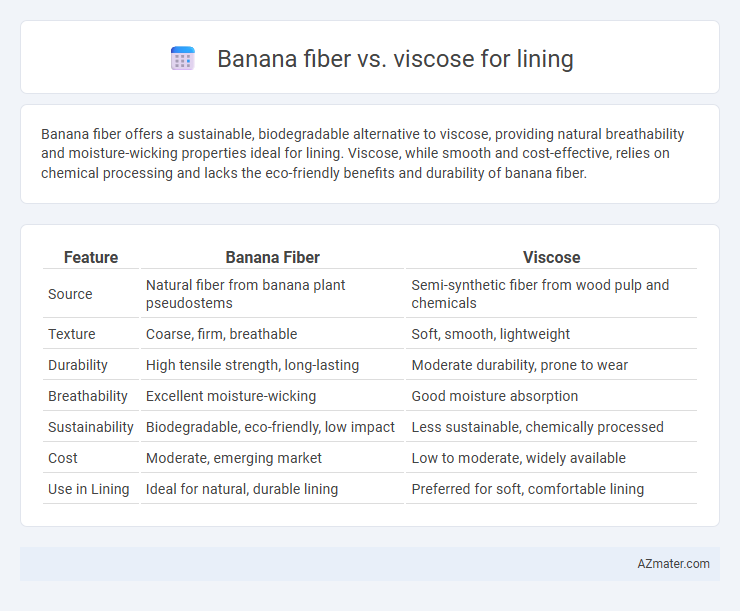Banana fiber offers a sustainable, biodegradable alternative to viscose, providing natural breathability and moisture-wicking properties ideal for lining. Viscose, while smooth and cost-effective, relies on chemical processing and lacks the eco-friendly benefits and durability of banana fiber.
Table of Comparison
| Feature | Banana Fiber | Viscose |
|---|---|---|
| Source | Natural fiber from banana plant pseudostems | Semi-synthetic fiber from wood pulp and chemicals |
| Texture | Coarse, firm, breathable | Soft, smooth, lightweight |
| Durability | High tensile strength, long-lasting | Moderate durability, prone to wear |
| Breathability | Excellent moisture-wicking | Good moisture absorption |
| Sustainability | Biodegradable, eco-friendly, low impact | Less sustainable, chemically processed |
| Cost | Moderate, emerging market | Low to moderate, widely available |
| Use in Lining | Ideal for natural, durable lining | Preferred for soft, comfortable lining |
Introduction to Banana Fiber and Viscose
Banana fiber, derived from the pseudostem of banana plants, is a natural, eco-friendly textile known for its strength, biodegradability, and moisture-wicking properties, making it an excellent choice for sustainable lining materials. Viscose, a semi-synthetic fiber made from regenerated cellulose, offers a smooth, soft texture with high breathability and drape, commonly used in linings for comfort and affordability. Comparing banana fiber and viscose reveals a trade-off between natural sustainability and processing efficiency, influencing their application in eco-conscious and performance-focused textile products.
Origins and Production Processes
Banana fiber originates from the pseudostems of banana plants, primarily cultivated in tropical regions such as India and the Philippines, and is extracted through a manual or mechanical decortication process that separates fibers before they are cleaned and spun. Viscose is a semi-synthetic fiber derived from cellulose sources like wood pulp, undergoing chemical treatment involving steeping, xanthation, and regeneration in an acidic bath to create continuous filaments. The sustainable extraction of banana fiber contrasts with the chemically intensive production of viscose, influencing environmental impact and fiber characteristics used in linings.
Environmental Impact Comparison
Banana fiber for lining offers a significantly lower environmental footprint than viscose, as it is a natural, biodegradable byproduct of banana plants requiring minimal chemical processing. In contrast, viscose production involves intensive use of chemicals like sodium hydroxide and carbon disulfide, contributing to water pollution and high energy consumption. Utilizing banana fiber supports sustainable agriculture and reduces deforestation risks linked to viscose's wood pulp sourcing.
Physical Properties and Texture
Banana fiber exhibits high tensile strength, natural breathability, and a coarse texture that enhances durability and provides an eco-friendly alternative for lining. Viscose, a semi-synthetic fiber, offers a smooth, soft texture with excellent drape and moisture absorption but lacks the robustness of banana fiber. The physical properties of banana fiber make it more suitable for applications requiring sturdiness, while viscose excels in comfort and a luxurious feel.
Comfort and Breathability
Banana fiber offers superior breathability compared to viscose, allowing better air circulation and moisture absorption, which enhances overall comfort in garment linings. Viscose, while soft and smooth, tends to retain moisture longer, potentially reducing breathability and causing a less comfortable wear over extended periods. Choosing banana fiber for lining ensures a natural, eco-friendly option that maintains dryness and comfort, especially in warm or humid conditions.
Durability and Longevity
Banana fiber offers superior durability and longevity compared to viscose due to its natural strength and resistance to wear and tear, making it ideal for high-quality garment linings. Viscose, while smoother and softer, tends to degrade faster with frequent washing and exposure to moisture, leading to a shorter lifespan. Choosing banana fiber lining enhances the garment's structural integrity and provides sustained performance over time.
Cost and Economic Considerations
Banana fiber, derived from banana plant stems, offers a sustainable and biodegradable option with generally lower production costs compared to viscose, which requires extensive chemical processing and higher energy consumption. While viscose linings provide a smoother texture and consistent quality, the economic benefits of banana fiber include reduced environmental impact and potential cost savings in raw material sourcing. Choosing banana fiber for lining applications can enhance affordability and support eco-friendly manufacturing practices without significantly compromising durability.
Dyeing and Color Retention
Banana fiber exhibits excellent dye absorption due to its high cellulose content, resulting in vibrant and long-lasting colors when used for lining. Viscose also offers good dye affinity but tends to fade faster under repeated washing and exposure to sunlight compared to banana fiber. The natural strength and breathability of banana fiber contribute to superior color retention and durability in lining applications.
Suitability for Garment Lining
Banana fiber exhibits high breathability, moisture-wicking properties, and natural durability, making it an eco-friendly choice for lining breathable garments, particularly in warmer climates. Viscose offers a smooth, silky texture that enhances comfort and ease of garment movement, ideal for formal and delicate apparel requiring a luxurious finish. Suitability depends on the desired balance between sustainability and softness, with banana fiber favored for natural performance and viscose preferred for refined aesthetics in suit lining.
Conclusion: Which is the Better Choice?
Banana fiber offers superior sustainability with its biodegradable properties and low environmental impact compared to viscose, which involves chemical-intensive production. In terms of durability and breathability, banana fiber provides a natural, strong, and moisture-wicking lining ideal for eco-conscious fashion. For those prioritizing eco-friendly materials without compromising functionality, banana fiber proves to be the better choice over viscose for lining purposes.

Infographic: Banana fiber vs Viscose for Lining
 azmater.com
azmater.com